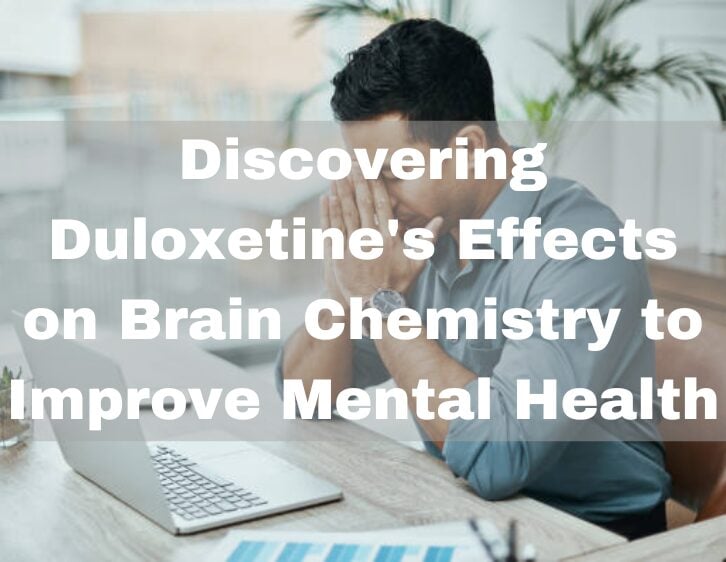People who work in mental health treatments are always looking for better medicines. One strong candidate among the many drug-based treatments is duloxetine, known for its unique way of working and hopeful results. This medicine can help with more than just sadness. It can also help with chronic pain and generalized anxiety disorder.
But what makes this medicine different from other drugs, and how does it help with symptoms? We will discuss the exciting subject of duloxetine in this blog post, looking at how it changes the brain’s chemistry and might be good for mental health.
The Science Behind Duloxetine
To maximize the therapeutic effects of duloxetine in mental health treatment, it is imperative to comprehend the complex mechanisms underlying these effects. This antidepressant’s importance in treating mood disorders and chronic pain is highlighted by its dual impact on serotonin and norepinephrine, as well as its receptor affinity and possible influence on neuroplasticity.
How It Works
Duloxetine acts on several neurotransmitter systems involved in processing pain and regulating mood. It has a therapeutic impact by preventing serotonin and norepinephrine from being reabsorbed, prolonging their stay in the synaptic cleft. This is necessary for maintaining the chemical balance of the brain and controlling neurotransmission.
Serotonin Reuptake Inhibition
The “feel-good” chemical serotonin regulates mood, appetite, sleep patterns, and mental processes. Anxiety and depression symptoms may be brought on by or maintained by serotonin dysregulation or deficiency. By inhibiting serotonin from being absorbed into presynaptic neurons, duloxetine increases the serotonin available in the synaptic space, which regulates mood.
Norepinephrine Reuptake Inhibition
Norepinephrine controls stress, arousal, and attention. Duloxetine affects this hormone. Fatigue, apathy, and difficulty focusing might be symptoms of mood disorders caused by low norepinephrine levels. This medicine improves alertness, motivation, and cognition by reducing norepinephrine reuptake and increasing synaptic concentration.
Affinity for Receptors and More
Apart from neurotransmitter reuptake, duloxetine has varying degrees of affinity for many receptors located throughout the central nervous system. Reuptake inhibition is its primary mechanism, but receptor interactions may influence its pharmacological profile and therapeutic efficacy.
Serotonin and Norepinephrine Receptor Subtypes
Duloxetine binds to subtypes of serotonin and norepinephrine receptors and reuptake transporters. Interacting with specific receptors modifies neurotransmission and increases its therapeutic advantages. Although the precise effects of these receptor interactions are unknown, they may be a factor in this medicine’s broad spectrum of therapeutic effects.
Neuroplasticity and Neuroprotection
Duloxetine may affect neuroplasticity, the brain’s ability to adapt to external stimuli, according to recent studies. By increasing neuroplasticity and fostering new brain connections, this medicine may lessen stress and the long-term effects of mental illness.
Future Directions
Pharmacotherapy will evolve with brain chemistry and mental disorder knowledge. Research is underway to understand duloxetine’s therapeutic mechanisms and find new psychiatric and neurological treatment targets. From understanding its molecular connections to studying its prospective uses in developing neuroscience fields, this medicine and other similar drugs have fascinating prospects.
Precision Medicine
Personalized medicine and genetics could lead to more individualized mental health treatments. Clinicians can maximize effectiveness and reduce side effects by finding genetic markers of medication metabolism or treatment response. Duloxetine’s therapeutic benefits and patient outcomes could be significantly enhanced by this customized approach.
Novel Therapeutic Targets
New neurotransmitter systems, signaling pathways, and neuroplasticity mechanisms contribute to advancing psychiatric pharmacology. As they investigate brain function and dysfunction, researchers may find novel targets for treatment that enhance the mechanisms of action of duloxetine or provide alternative avenues for intervention. Pharmaceutical therapies for mental illnesses may benefit from glutamatergic modulation and epigenetic regulation.
Clinical Applications
Not only does duloxetine treat anxiety and depression, but it also treats a wide range of mental and neurological issues. Patients with mental illnesses can find hope from its diverse pharmacological profile, which can be used to treat PTSD, OCD, and chronic pain syndromes.
Depression and Anxiety
Duloxetine is primarily prescribed for major depressive disorder (MDD) and generalized anxiety disorder (GAD). Clinical trials have demonstrated its efficacy in alleviating sadness, hopelessness, worry, and irritability. By rebalancing neurotransmitter levels, duloxetine helps to regulate mood and restore emotional stability in individuals with these conditions.
Chronic Pain Management
Duloxetine is used to treat psychological disorders as well as chronic pain. This includes the extensive pain and sensitivity in the musculoskeletal system caused by fibromyalgia. Patients with chronic pain benefit from duloxetine’s modulation of serotonin and norepinephrine levels, which lowers pain and enhances physical function.
Other Applications
Apart from depression, anxiety, and chronic pain, duloxetine may be used to treat a variety of neurological and psychological issues. Research suggests that it may be beneficial for neuropathic pain, OCD, and PTSD. Although the initial findings are encouraging, more investigation is required to understand its effectiveness fully.
Potential Benefits and Considerations
Examining the complex range of duloxetine’s effects suggests a balance between benefits and things to remember while using it in clinical settings. Comprehending these variables is crucial for maximizing therapy results and fostering patient welfare since they range from improved tolerability and extensive therapeutic applications to withdrawal issues and individual variance.
Enhanced Tolerability
Duloxetine has a few noteworthy advantages over several other antidepressants, one of which is its more good side effect profile. Compared to SSRIs, which predominantly target serotonin, they may have fewer sexual adverse effects since they affect both norepinephrine and serotonin. Its once-daily dosage schedule further increases patient convenience and adherence.
Withdrawal Concerns
Like many neurotransmitter medications, duloxetine can cause withdrawal symptoms if stopped suddenly. It’s possible to experience flu-like symptoms, confusion, nausea, and irritability. Patients must taper off this medicine gradually under medical supervision to lower the danger of withdrawal.
Individual Variation
Individual responses to duloxetine can differ, just like with any medicine. While some people respond well or have manageable side effects, others may not respond well at all or may experience severe symptom relief. With the assistance of a healthcare provider’s knowledge, selecting the appropriate prescription and dosage frequently entails a process of trial and error.
A Path to Mental Health with Duloxetine
Duloxetine’s brain chemistry effects suggest a promising mental health treatment pathway. This kind of medicine treats mood disorders and chronic pain in multiple ways by acting on serotonin and norepinephrine. Understanding its complex mechanisms, from neurotransmitter reuptake inhibition to receptor affinity and beyond, illuminates its therapeutic promise in neurological and psychiatric diseases.
Duloxetine’s future rests in customized treatment and continued study. Advances in pharmacology, customized treatment approaches, and combination drugs may enhance patient outcomes and well-being. For additional information, look into the individualized mental health treatment options USA Script Helpers offers.


















